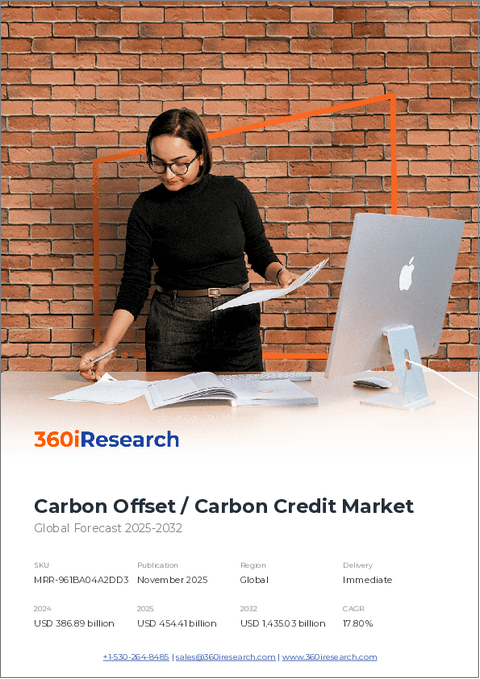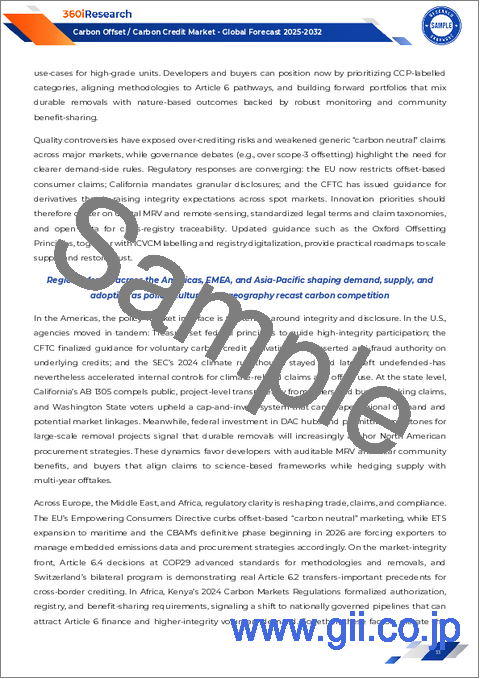|
|
市場調査レポート
商品コード
1808444
カーボンオフセット/カーボンクレジット市場:市場タイプ別、クレジットタイプ別、プロジェクトタイプ別、クレジット規格別、配信メカニズム別、エンドユーザー別-2025年~2030年世界予測Carbon Offset / Carbon Credit Market by Market Type, Credit Type, Project Type, Credit Standard, Delivery Mechanism, End User - Global Forecast 2025-2030 |
||||||
カスタマイズ可能
適宜更新あり
|
|||||||
| カーボンオフセット/カーボンクレジット市場:市場タイプ別、クレジットタイプ別、プロジェクトタイプ別、クレジット規格別、配信メカニズム別、エンドユーザー別-2025年~2030年世界予測 |
|
出版日: 2025年08月28日
発行: 360iResearch
ページ情報: 英文 180 Pages
納期: 即日から翌営業日
|
概要
カーボンオフセット/カーボンクレジット市場は、2024年には4,498億9,000万米ドルとなり、2025年には5,525億6,000万米ドル、CAGR23.97%で成長し、2030年には1兆6,332億1,000万米ドルに達すると予測されています。
| 主な市場の統計 | |
|---|---|
| 基準年2024年 | 4,498億9,000万米ドル |
| 推定年2025年 | 5,525億6,000万米ドル |
| 予測年2030年 | 1兆6,332億1,000万米ドル |
| CAGR(%) | 23.97% |
世界のカーボンクレジット市場とその利害関係者にとっての戦略的意味を包括的に検討するための舞台設定
気候変動の緊急性の高まりは、カーボンクレジットを企業戦略や政策課題の最前線に押し上げました。企業が規制圧力の高まりや利害関係者の期待の高まりに直面する中、温室効果ガスの排出量を定量化し、取引し、中和する仕組みがかつてないほど重要になっています。本レポートは、カーボンクレジットのエコシステムを形成する多面的な力学を明らかにし、現代の状況を定義する政策的軌道、市場構造、技術的介入を俯瞰します。
技術革新を通じてカーボンクレジットの状況を形成する主な変革的転換をナビゲートする政策展開と市場力学
過去10年間、カーボンクレジットの状況は、モニタリング技術の飛躍的な進歩、規制状況の進化、利害関係者のダイナミックな期待によって、激震的な変化を遂げてきました。初歩的な検証モデルからデジタル元帳システムへと移行することで、これまでにない透明性とトレーサビリティが実現し、買い手と売り手の間でより大きな信頼が生まれました。同時に各国政府は、野心的な排出削減目標に沿うようコンプライアンス・アーキテクチャーを改良し、地域市場に波及する政策更新の連鎖を引き起こしました。
2025年における米国の関税導入がカーボンクレジットの流れに与える累積的影響を検証するコンプライアンス市場とグローバルな貿易関係が注目されています
2025年に米国が特定のカーボンクレジットに関税を導入することは、世界の排出権取引にとって極めて重要な転換点となります。当初は国内のコンプライアンス市場を保護する目的で導入されたこの関税は、複雑な国際貿易の流れの再編成を引き起こしました。改正された関税制度の下では、輸入された回避・除去クレジットは差別化されたレートに直面し、国境を越えた取引の経済性を再調整する一方で、国内プロジェクト開発にインセンティブを与えています。
市場セグメンテーションの洞察:コンプライアンスとボランタリー、クレジットタイプ分類、プロジェクトタイプ分類、クレジット基準、デリバリーメカニズム、エンドユーザーなど、市場タイプに応じた実用的なセグメンテーションの洞察を明らかにします
綿密なセグメンテーション分析により、市場タイプごとに異なるダイナミクスが明らかになりました。そこでは、コンプライアンスの義務化が予測可能な需要カーブを描く一方、自主的な取り組みが進化する企業価値や消費者心理に対応しています。規制上の制約を受ける企業は長期的な購入契約を結ぶ傾向がある一方、自主的な参加企業はより機敏な調達アプローチを採用し、クレジットの取得をブランドのポジショニングとESG報告のタイムラインに合わせています。
南北アメリカ、中東・アフリカ、アジア太平洋のカーボンクレジット・エコシステムにおける主要地域ダイナミクスと促進要因の解明
南北アメリカの地域力学は、米国とカナダにおける成熟したコンプライアンス枠組みと、それを補完する強固な自主市場によって形成されています。北米の規制当局は、ダイナミックな割当メカニズムとレジストリの相互運用性の強化を通じて、プログラムの進化を促進しています。一方、ラテンアメリカの管轄区域は、特に林業と再生可能エネルギー・クレジットの重要な供給拠点として台頭しつつあり、これは広大な自然の炭素吸収源と支持的な政策環境に後押しされています。
主要企業の戦略的プロファイルをハイライトすることで、カーボンクレジット分野における競争ダイナミクスとイノベーションの道筋、そして競合他社との協業機会を明らかにします
カーボンクレジットの状況を戦略的に見直すと、市場の輪郭を決定づける多様な有力企業の存在が浮かび上がってくる。検証や発行を専門とするレジストリ事業者は、監査証跡を強化するためにデジタル台帳技術に投資しており、取引プラットフォームは、マッチングプロセスを合理化し、新たな流動性プールを解放するためにAI主導の分析を統合しています。プロジェクト開発会社は、セクター横断的な提携を結び、技術的専門知識と現地の利害関係者ネットワークを融合させて、林業、再生可能エネルギー、産業削減プログラムへの初期段階投資のリスクを軽減しています。
持続可能な成長を促進するため、業界リーダーに実行可能な提言を提供ポートフォリオ戦略の最適化と炭素市場参入の強化
進化するカーボンクレジットの情勢を乗り切るために、業界リーダーはまず、回避クレジットと除去クレジットの両方を統合することによってポートフォリオを多様化し、コストと長期的な環境永続性のバランスをとるべきです。ハイブリッド調達戦略を採用することで、組織はネットゼロ目標への全体的なコミットメントを示しつつ、政策転換から身を守ることができます。次に、特に大規模な排出削減のコミットメントを追求する場合、認知された基準に合わせ、プログラムレベルの手段を活用することで、コンプライアンス・プロセスを迅速化し、ボリュームディスカウントを引き出すことができます。
1次調査と2次調査を統合した厳密な調査手法信頼性のための分析フレームワークと品質保証プロトコル
本レポートの分析基盤は、一次関係者インタビューと広範な二次情報調査の両方を統合した厳密な調査手法に基づいています。一次データ収集では、政策立案者、登録機関運営者、プロジェクト開発者、企業の持続可能性担当者、金融仲介業者との綿密なインタビューが行われました。これらのディスカッションは、市場の促進要因、規制当局の期待、運用のベストプラクティスなどに関する微妙な視点を把握するために行われました。
市場の軌跡に関する洞察に満ちた結論を導き出す進化する世界のカーボンクレジット・エコシステムにおける利害関係者の影響と戦略的課題
世界のカーボンクレジット・エコシステムは、政策革新、技術進歩、市場統合が収束し、脱炭素ファイナンスの新時代を定義する、変革の岐路に立っています。利害関係者は、コンプライアンス義務と自主的な野心との相互作用に警戒を怠らず、規制状況が変化する中でハイブリッド・アプローチが最大の回復力を発揮することを認識しなければならないです。地域市場が成熟するにつれ、新たなベストプラクティスや同等性の枠組みとの戦略的な整合性が、競争上の位置づけやプレミアム・クレジット・ポートフォリオへのアクセスを決定することになります。
目次
第1章 序文
第2章 調査手法
第3章 エグゼクティブサマリー
第4章 市場の概要
第5章 市場力学
- 恒久的な除去の需要が高まるにつれて、直接空気回収プロジェクトからの炭素除去クレジットの採用が進む
- 義務的なカーボンクレジット開示と標準化された報告プロトコルを推進する規制枠組みの拡大
- AIを活用したプロジェクト検証を活用し、高信頼性炭素除去イニシアチブの承認を加速
- 大規模で柔軟な調達オプションを提供する、企業サブスクリプションベースのカーボンクレジット調達モデルの台頭
- 重工業のプロセス排出量を相殺するためのセクター別カーボンクレジットプログラムの出現
- 東南アジアにおける社会的共益を生み出す地域コミュニティ主導のマングローブ再生クレジットの開発
- 単なるトン数を超えた、検証済みの生物多様性の共同便益に結びついたパフォーマンス連動型クレジット価格設定の利用増加
- 開発途上国のホストプロジェクトと世界の購入者を結びつける国境を越えたカーボンクレジット取引プラットフォームの成長
- 初期段階の林業プロジェクトのリスクを軽減するために、譲許的融資と炭素収入を組み合わせたハイブリッドな資金調達メカニズムを採用する
- 利害関係者の監視の強化に対応するため、カーボンクレジット認証フレームワークに社会的影響指標を統合する
第6章 市場洞察
- ポーターのファイブフォース分析
- PESTEL分析
第7章 米国の関税の累積的な影響2025年
第8章 カーボンオフセット/カーボンクレジット市場:市場タイプ別
- コンプライアンス
- ボランタリー
第9章 カーボンオフセット/カーボンクレジット市場:クレジットタイプ別
- 回避/削減クレジット
- 削除クレジット
第10章 カーボンオフセット/カーボンクレジット市場:プロジェクトタイプ別
- エネルギー効率
- 林業
- 工業プロセス
- 再生可能エネルギー
- 廃棄物管理
第11章 カーボンオフセット/カーボンクレジット市場:クレジット規格別
- アメリカカーボンレジストリ
- CDM
- ゴールドスタンダード
- VCS
第12章 カーボンオフセット/カーボンクレジット市場:配信メカニズム別
- プログラムレベル
- プロジェクトレベル
第13章 カーボンオフセット/カーボンクレジット市場:市場:エンドユーザー別
- 企業
- 政府
- 機関投資家
- NGO
第14章 南北アメリカのカーボンオフセット/カーボンクレジット市場
- 米国
- カナダ
- メキシコ
- ブラジル
- アルゼンチン
第15章 欧州・中東・アフリカのカーボンオフセット/カーボンクレジット市場
- 英国
- ドイツ
- フランス
- ロシア
- イタリア
- スペイン
- アラブ首長国連邦
- サウジアラビア
- 南アフリカ
- デンマーク
- オランダ
- カタール
- フィンランド
- スウェーデン
- ナイジェリア
- エジプト
- トルコ
- イスラエル
- ノルウェー
- ポーランド
- スイス
第16章 アジア太平洋のカーボンオフセット/カーボンクレジット市場
- 中国
- インド
- 日本
- オーストラリア
- 韓国
- インドネシア
- タイ
- フィリピン
- マレーシア
- シンガポール
- ベトナム
- 台湾
第17章 競合情勢
- 市場シェア分析, 2024年
- FPNVポジショニングマトリックス, 2024年
- 競合分析
- 3Degrees Group, Inc.
- Carbon Credit Capital, LLC
- 5D Net Zero
- Anthesis Group
- BHP Group PLC
- Boreal Carbon Corporation
- Carbon Footprint Ltd.
- CarbonBetter
- CarbonClick Limited
- Circular Ecology Ltd.
- ClearSky Climate Solutions, LLC
- Climate Finance Asia Ltd
- ClimeCo LLC
- CMA CGM Group
- Cool Effect, Inc.
- Coral Future Pte. Ltd.
- Ecohz
- Ecologi Action Ltd
- EDF Energy
- EKI Energy Services Limited
- GALP Energia
- Green Mountain Energy
- Greenfleet Australia
- Native
- Planetair
- Restitution Brands LLC dba Terrapass
- Shell International B.V.
- Sterling Planet
- WGL Holdings, Inc.





